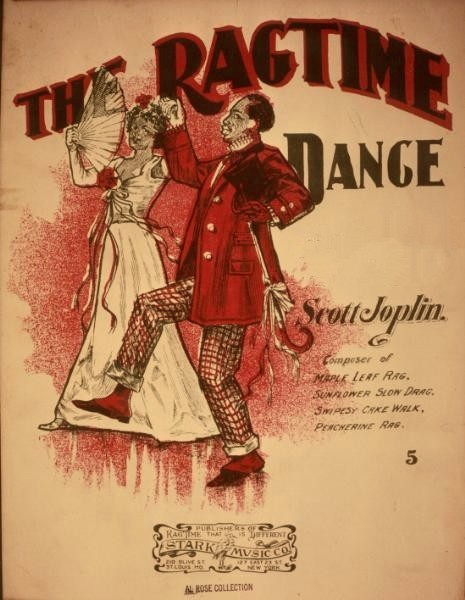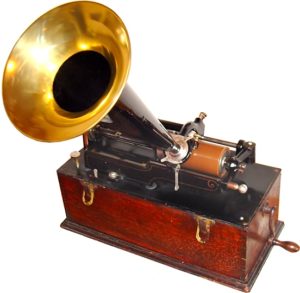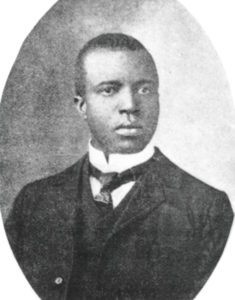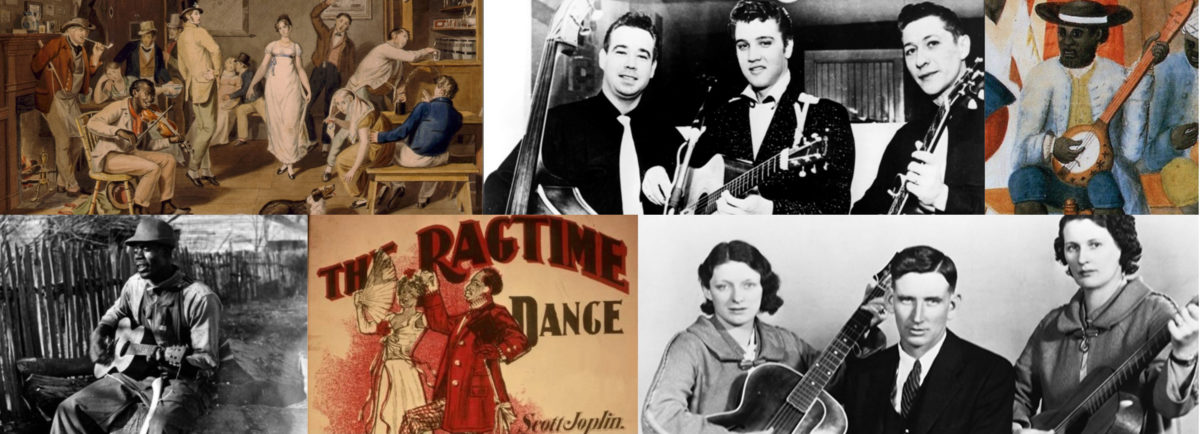
Overview
Ragtime was one of the most popular forms of music in the United States between 1897 and 1917. Rooted in African American folk dance traditions, it evolved in the decades after emancipation, incorporating both African and European musical elements. The genre eventually took a variety of forms, including vocal and instrumental music, intended for a listening audience. Ragtime and blues, a related African American musical form that developed concurrently, are essential components in jazz music, which rose in popularity as interest in ragtime waned.
Ragtime derived its name from the insistent, highly-syncopated “ragged” rhythm that distinguished it from other contemporary styles. Rhythmic syncopation pre-dated this era and style, but ragtime gained notoriety for its pervasive use throughout a composition or improvisation. Syncopation occurs when notes are stressed or accented between beats, interrupting the regular flow of rhythm and emphasizing the weaker beats. It results in more rhythmic diversity and excitement.
The suffix “-time,” as commonly applied in the late nineteenth century, referenced the rhythm of a musical composition: jig-time, waltz-time, march-time, etc. The term “ragtime” likely derived from a contraction of “ragged-time,” indicating the highly-syncopated rhythm that characterizes the music.
Ragtime emerged from African American communities in the South after the Civil War. It burst onto the national stage during the Gilded Age in the 1890s, when sentimental love songs dominated popular music. While dancers and audiences, both black and white, embraced it, some scorned it as an African American cultural invasion. Ragtime and the music industry, including sheet music publishing and new phonograph and player piano technologies, enjoyed a symbiotic relationship and rapid growth.

African American Music in Popular Culture
Fifty years before ragtime became a national sensation, touring minstrel troupes gave much of white America its first taste of a version of black music. Though filtered through white performers in blackface makeup, the music incorporated African American folk elements, including banjo styles learned from Southern black musicians.
Capitalizing on negative stereotypes of African Americans, minstrel shows were the most popular form of entertainment in the United States in the middle decades of the century. They were enjoyed primarily by middle and lower class white audiences. While white performers dominated the industry, black troupes also participated in minstrelsy since the 1840s. Eager for any opportunity for advancement, African American entertainers took to the minstrel stage in increasing numbers in the decades after emancipation.
Also after the end of slavery, spirituals gained exposure and respectability outside of the plantation context in which they originated. Elite white people deemed these religious songs more acceptable than those from the minstrel stage, perhaps, because they reinforced the values of Christian America. The abolitionists who assembled the 1867 book Slave Songs of the United States, the first published collection of spirituals, observed incorrectly that secular songs were rare among African Americans. In the 1870s, the Fisk Jubilee singers brought further acceptance to black religious music through their performances of choral arrangements of spirituals on concert stages.
Roots of Ragtime
Banjo and Fiddle
On southern plantations, enslaved African Americans played the fiddle for their masters' dances as well as their own. Their repertoire included Scottish, Irish, and English fiddle tunes that had little syncopation. The rhythms of these tunes, and new tunes that emerged, grew more complex and syncopated when the fiddle was paired with the banjo, which has roots in West Africa. In the 1830s and beyond, blackface minstrel performers imitated southern African American song and dance, albeit in a highly offensive way, in ensembles that included fiddle, banjo, tambourine, and rhythm bones. The minstrel performers, and resultant sheet music and banjo method books, acclimated mainstream America to the sound of these syncopated rhythms.
Piano
By the late nineteenth century, the piano was common in the parlors of American homes. While many African Americans could not afford pianos, they purchased smaller, less-expensive keyboard instruments, including organs and harmoniums, on lifetime installment plans. As few could read music, they improvised and adapted their syncopated banjo styles to keyboard instruments. A technique developed in which the left hand held down a steady rhythm, while the right hand played a syncopated melody – a hallmark of ragtime piano.
March
A march represents both a type of song and dance. In the mid-1800s, most formal balls for elite society in Europe and America began with a Grand March, which consisted of a variety of figures. The Grand Promenade kicked off the march, with couples entering the hall in a procession and marching in time to the music around the perimeter of the room. When publishers began issuing ragtime sheet music in the 1890s, the cover pages frequently indicated the dances for which it was appropriate, most commonly the march, two-step, and cakewalk.
Musically, marches have a strong regular rhythm and are commonly associated with military brass bands and orchestras. Most of the great European composers of the eighteenth and nineteenth centuries, including Beethoven, Mozart, Berlioz, and Tchaikovsky, wrote marches. In the United States, John Philip Sousa was the most prominent march composer. He was a member of and director of the United States Marine Band for much of the second half of the nineteenth century. His best-known marches include “The Stars and Stripes Forever,” “Semper Fidelis,” and “The Washington Post.” Instrumental ragtime music merges standard musical structures of marches with syncopated piano styles.
Cakewalk
Originating on Southern plantations, cakewalks constituted a type of dance contest and its accompanying music. Black couples performed high-stepping, exaggerated motions that imitated and mocked the Grand Promenade that was popular with high-society whites. The winning couple won the prize of a cake, which is the origin of the phrase “takes the cake.” Minstrel performers incorporated cakewalks into their shows, introducing the dance to white audiences. By the 1890s, cakewalks were popular in the ballrooms of the United States and Europe.
With pianos in so many middle-class American homes, the sale of sheet music became big business. As the cakewalk dance grew in popularity, publishers issued many cakewalk marches that included light syncopation.
The Emergence of Ragtime
In the second half of the nineteenth century, itinerant black musicians traveled in various parts of the country, playing for tips or wages in saloons, brothels, gambling halls, and restaurants. They commonly “ragged” popular songs, classical pieces, and marches by adding syncopated rhythms that were not part of the original composition. Before the ragtime name became common, the style was frequently called “jig piano.” After hours, the pianists played for one another and held informal contests in the back rooms of bars. Cities that had ragtime or jig piano players during the music’s formative days include New Orleans, New York, Philadelphia, Baltimore, St. Louis, Mobile, Louisville, and Memphis.
Newspapers and other accounts indicate that ragtime was introduced to the general public in 1893 at the Chicago World’s Fair. Though the evidence is scant and there is no record of official ragtime exhibitions at the Fair, some assert that many traveling ragtime pianists converged in Chicago at the time and held contests throughout the city.
Vocal Ragtime
Though many people consider ragtime an instrumental piano genre, during the period of the music’s peak popularity, the term also referred to vocal compositions. The words “rag” and “rag time” first appeared in 1896 on sheet music for “coon songs.” Contemporary sources did not distinguish between coon songs and other forms of ragtime.
The lyrics of coon songs portray African Americans, and mock their dialect, in an extremely derogatory manner. They were a more explicit and offensive outgrowth of a type of blackface minstrel song that had declined in popularity after the Civil War. The racist nature of coon songs embodied white fear of African American migration to cities. The songs and imagery on sheet music covers updated antebellum minstrel stereotypes by depicting blacks as primitive residents of modern, urban environments, trying to impress with sophisticated dress and speech.
Both black and white songwriters and performers participated in propagating the “coon craze.” Black songwriter Ernest Hogan wrote the first coon song that became a huge hit, “All Coons Look Alike to Me,” published in 1896. Hogan and other African American songwriters and performers used this vehicle, as well as minstrelsy, to advance their professional careers in a time of limited opportunity. Most avoided using the more cruel stereotypes in their songs, but they were not without their critics. A 1901 article in Indianapolis Freeman, a black newspaper, noted, “The colored man writes the ‘coon’ song, the colored singer sings the ‘coon’ song, the colored race is compelled to stand for the belittling and ignominy of the ‘coon’ song, but the money from the ‘coon’ song flows with ceaseless activity into the white man’s pockets.”
Most of the criticism leveled at coon songs was for their vulgarity, not their racist content. The songs peaked in popularity between 1896 and 1906. While the explicitly racist elements gradually faded, blackface minstrelsy continued in recordings, radio, motion pictures, and television well into the 1950s.
Not all ragtime vocal songs were coon songs. After 1896, sheet music and phonograph records that included “rag” or “ragtime” in the title or description grew in popularity. Often, black pianists who could not read or write music played their compositions for Tin Pan Alley songwriters who notated and published them. Sometimes the original composers were credited and compensated, and sometimes not.
Many composers wrote vocal ragtime songs, including George M. Cohan, Irving Berlin, Jean Schwartz, Louise Hirsh, and Lewis F. Muir.
“Oh! You Beautiful Doll” was published in 1911. Seymour Brown wrote the lyric, and Nat D. Ayer composed the music. This recording by American Quartet, featuring Billy Murray, was a #1 hit in early 1912.
Piano Ragtime
Piano ragtime refers to composed instrumental pieces played on the piano. Many people consider Theodore Northrup’s Louisiana Rag (1897) to be the first published piano ragtime.
The song that truly launched the piano ragtime genre was Scott Joplin’s “Maple Leaf Rag,” published in 1899. It was hugely popular and became the blueprint for subsequent piano ragtime compositions. The song completed ragtime’s evolution from an improvised piano style for dancing to serious compositions that could be enjoyed by listening audiences.
Scott Joplin
Considered the King of ragtime, Scott Joplin was born in Texarkana, Texas, in 1868. He studied music with a German music teacher and played professionally from age 16. In 1894, Joplin moved to Sedalia, Missouri. There, he taught piano lessons and composed music, publishing his first pieces in 1895.

In 1901, following the success of “Maple Leaf Rag,” Joplin moved to St. Louis. He went on to compose more than 100 ragtime pieces, including a ragtime ballet and two ragtime operas. Joplin made piano-roll recordings and published an instructional manual, The School of Ragtime - Six Exercises for Piano, in 1908. Despite his tremendous success as a ragtime composer, he grew frustrated that critics did not perceive his ragtime ballet and operas as serious art.
Joplin and publisher John Stark used the term “classic ragtime” to indicate music of a superior artistic quality. Some still refer to piano ragtime pieces as classic ragtime to distinguish this type from the improvised and vocal variety. Composers James Scott and Joseph Lamb, along with Joplin, are generally regarded as the "big three" of classic ragtime.
St. Louis
St. Louis emerged as a significant hub for ragtime. The city enjoyed a regular flow of traffic as a stopover for north-south travelers on the Mississippi River, as well as east-west migrants. Many ragtime pianists and composers congregated in St. Louis to perform and publish their music, including Joplin, Scott Hayden, Charles L. Johnson, and Charles Hunter. In the many saloons on Chestnut and Market streets, ragtime pianists played day and night.
John Turpin and his son Thomas Million Turpin, known as the “Father of St. Louis Ragtime,” were the city’s most renowned patrons of ragtime music. John owned The Silver Dollar saloon, and Thomas owned Rosebud Bar and other establishments that provided places for ragtime pianists to perform and hone their craft. Thomas was also a pianist and composer who published his own piano rags. His 1897 piece “Harlem Rag” was the first piano rag by an African American composer to be published.
Responses to Ragtime
In the early 1890s, sheet music publications of sentimental love songs pervaded the parlors of middle-class American homes. When ragtime music entered the scene, millions of Americans, both black and white, embraced it, while some viewed it with scorn. Cultural critics denounced the syncopated rhythms of ragtime for corrupting moral values and musical tastes, much as later commentators would condemn blues, jazz, rock & roll, and hip-hop. As Paul G. Carr wrote in his article “Abuses of Music” for Musician magazine in October of 1901, “There is no element of intellectuality in the enjoyment of ragtime. It savors too much of the primeval conception of music, whose basis was a rhythm that appealed to the physical rather than to the mental senses.”
Ragtime also had proponents who defended the music. Advocates touted its popularity and general acceptance, even among European royalty and musicians. They noted its innovative qualities and uniquely American character. In the article “Rag-Time,” The Times in London wrote, “Now of the character of ‘rag-time’ there can be no doubt – it is absolutely characteristic of its inventors – from nowhere but the United States could such music have sprung.”
Musical Characteristics of Ragtime
The use of syncopated rhythms defines ragtime music. In piano ragtime, the left hand maintains a steady count of 1, 2, 3, 4 in the lower notes by playing an “oom-pah, oom-pah” rhythm. Click the triangle below to listen to the example. Notice visually how all the notes line up above the numbers 1, 2, 3, 4 and musically fall right on these beats.
Piano - Left Hand
The pianist's right hand plays the syncopated melody notes that are higher in pitch. The most common syncopated rhythm in early ragtime is the short-long-short rhythm. In the example below, notice visually how some notes appear in between the steady count of 1, 2, 3, 4. Listen for the syncopated rhythm of short-long-short-long-short-long.
Piano - Right Hand
In vocal songs marketed as ragtime, often there was little syncopation. The label “ragtime” was frequently used in a song title or description to boost sales because the genre was so popular. Some purists do not consider vocal songs as authentic ragtime for this reason, although they were generally considered ragtime by contemporaries. Irving Berlin’s 1911 hit “Alexander’s Ragtime Band” is an excellent example of a ragtime song with only marginal ragtime qualities.
Form
The form of a piece of music is its musical structure. Composed ragtime pieces, whether instrumental or vocal, generally adhered to forms that had been previously established in other genres of music. Form consists of various independent sections of a song, each delineated by a letter of the alphabet (A, B, C, D) and the order in which they occur. Each of these sections consists of a certain number of measures, or bars. In ragtime, a measure usually contains four beats (1, 2, 3, 4), as demonstrated in the musical examples provided above.
As professional Tin Pan Alley songwriters wrote many vocal ragtime songs, they generally follow the same popular song conventions. Among the most common forms is the 32-bar A A B A. Songs of this form consist of four sections: an 8-bar A section, a repeat of the 8-bar A section (with different lyrics and perhaps other slight changes, a B section which differs significantly, and finally a return to the A section.
Instrumental
ragtime pieces adhered to forms established by the march and other earlier dance music. In early ragtime compositions, this frequently consisted of 16-bar sections. The most common forms were A B, A B A, A B A C, and A B C D. Some songs included additional introductions or interludes that linked sections. As ragtime evolved, composers wrote songs with much greater variety and complexity in form.
Ragtime Bands
By the turn of the twentieth century, dance, marching, and concert bands included ragtime in their repertoires. They performed in dance halls, theaters, restaurants, and other venues. Publishers issued arrangements for bands, as well as many different instruments and instrument combinations. If a published band arrangement was not available, ensembles adapted piano sheet music to suit their instrumentation.
Brass bands and other ensembles frequently played from John Stark’s The Collection of Orchestrations of Classic Rags, published in 1912. New Orleans musicians, many of whom could not read music, struggled to play the challenging arrangements in “the red back book,” as it was commonly known. The partially-improvised approximations of these arrangements was one of the stepping stones to jazz, which started to displace ragtime in popularity around 1917, the year Scott Joplin died. The rise of dances not suited to ragtime music, including the one-step, tango, fox-trot, and waltz, also contributed to the decline of the genre.
Influence of Ragtime
Art Music
In 1905, Claude Debussy incorporated ragtime elements into his “Golliwog’s Cakewalk,” a movement of the piano suite Children’s Corner. Other composers of art music followed suit, including Igor Stravinsky, Paul Hindemith, Erik Satie, and John Alden Carpenter.
Blues and Jazz
Blues music developed as a genre within African American communities in the second half of the nineteenth century. After it took the national stage with W.C. Handy’s hit “Memphis Blues” in 1912, elements of blues and ragtime freely mingled. Ragtime rhythms appeared in blues songs, and blues melodies became more common in ragtime songs. Many sheet music titles included both the words blues and rag in title or description. Jazz music incorporated elements of both genres, and many early jazz pianists cut their teeth playing ragtime. Blues, however, remained popular and evolved throughout the jazz age of the 1920s and beyond, while ragtime did not.
Revival
A revival of interest in ragtime music started in the 1940s, led by white bandleader Lu Warner and his Yerba Buena Jass Band. The release of pioneering jazz pianist Jelly Roll Morton’s Library of Congress recordings in 1948 furthered interest in ragtime and early jazz styles. Since then, the music industry has released a steady stream of reissues and new ragtime recordings and sheet music.
The 1973 movie “The Sting,” set to a ragtime soundtrack, elevated the music to a height of popularity not seen since the second decade of the twentieth century. That year, composer and pianist Marvin Hamlish’s orchestra arrangement of Scott Joplin’s “The Entertainer” reached #3 on Billboard Magazine’s popular music chart. The movie takes place in the 1930s, more than a full decade after ragtime had all but vanished from America’s musical landscape. Nevertheless, it served to propel the popularity of ragtime into the future. Interest in ragtime music has continued to manifest in scholarship, live performance, and festivals.
Marvin Hamlisch’s orchestra arrangement of “The Entertainer,” from the movie The Sting
Playlists
Apple Music
Spotify
YouTube
Further Reading
Berlin, Edward. Ragtime: A Musical and Cultural History. Open Road Distribution, 2016.
Berlin, Edward A. King of Ragtime: Scott Joplin and His Era. Oxford University Press, 1994.
Jasen, David A., and Trebor Jay Tichenor. Rags and Ragtime: A Musical History. New York: Dover Publications, 2011.

